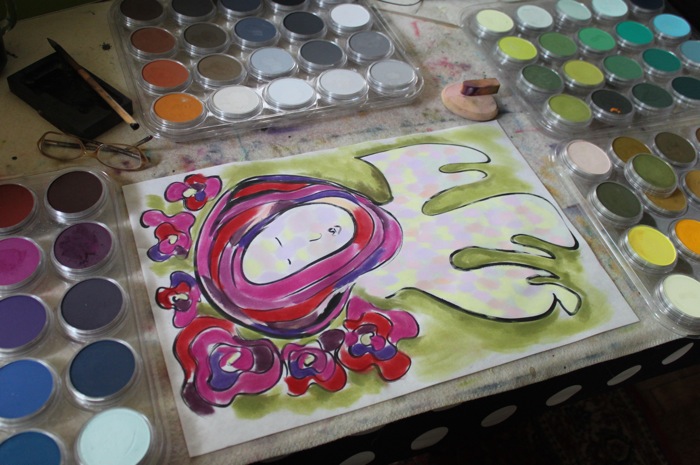


Q&A: Lisa Rydin Erickson
May 21, 2013


Installation Timelapse Videos – Krista Svalbonas
July 6, 2013PanPastel is a very versatile medium in terms of its ability to be used on such a wide variety of surfaces from toothy papers to smooth and even delicate papers. So in the next few months we’re going to be posting about using PanPastel on several different surfaces.
We are starting with a range of sanded papers from UART. We have always enjoyed using UART paper with our colors. Our friends at UART sent us a full selection of papers to try for this post. And some for a giveaway too (more about that later!).


Grade no. is printed on the back of each UART sheet
The first thing I did was make one long continuous mark using PanPastel Phthalo Green with a Sofft Sponge Bar on a sheet of each grade. On the finer tooth papers – 800 & 600 (1st & 2nd from left) you can see the color stays uniform from the beginning of the mark to the end of the mark. (Click on any of the images below to see more detail with a larger size image).
240 (far right) is the coarsest of the papers as it has the largest tooth, so the color was “grabbed” more quickly by the paper as I made the mark, that’s why at the end of the mark the color began to thin out a little. Which means that on the coarser grades the sponge applicator needs to be re-loaded with color more frequently.
PanPastel Phthalo Green (620.5) on 7 grades of UART Sanded Papers From Left to Right: 800 – 600 – 500 – 400 – 320 – 280 – 240
I also layered two colors. That worked beautifully. You can see the results below.
Phthalo Green Shade (620.3) & Violet Shade (470.3) layered
PanPastel can be erased from almost any surface (prior to fixing) so I used a vinyl eraser to erase some color. Despite the holding power of the sandpaper, I was still able to erase the color cleanly, which means that changes or corrections can be made easily.
Erased PanPastel color (220.8 & 470.3) using a vinyl eraser
It was very easy to blend colors on the UART surfaces. I loved how the paper showed off how rich and saturated PanPastel Colors are.
Red Iron Oxides (380.1/3/5/8)
I also compared the results of blocking in some color with a pastel stick and PanPastel.
Pastel stick color (left) – PanPastel color (right)
We often get asked whether Sofft Sponge Tools can be used on sand-paper. Sponge on sand-paper? The answer is yes. Of course over time there is some wear, and the thinner sponges like the knife covers will wear down more quickly. But the thicker sponges e.g. sponge bars and angle slice sponges held up nicely after quite a lot of use on all of the different grades of UART. (Tip: Avoid being heavy-handed when applying the color, there is no need to apply a lot of pressure as it doesn’t change the amount of color that will be applied, and helps to reduce any wear and tear on sanded papers.)
Angle Slice and Sponge Bar after use on sanded papers
New to sanded papers? Many pastel artists like toothy surfaces as they can build up many layers of pastel color before filling the tooth. However for the first-time user sanded papers can be challenging to work with in the beginning, so it is a good idea to slowly move into sanded papers by starting with the finer/less toothy grades first until you get used to working with the “grab” of sanded surfaces, and then graduating to the toothier grades.
For more information about UART Papers visit: uartpastelpaper.com
Now for the giveaway – 5 lucky winners will receive a free UART Trial Pack (7 sheets), along with 3 PanPastel Colors of their choice! All you have to do is complete the giveaway form by midnight EST (New York time) Sunday June 2nd.
UPDATE 6/3/16 – the winners have been randomly drawn. Congratulations to: Gerd Andersson (Sweden), Cora Pearl (USA), Martha Wagoner (USA), Candice Thomas (USA), Beryl (UK)











